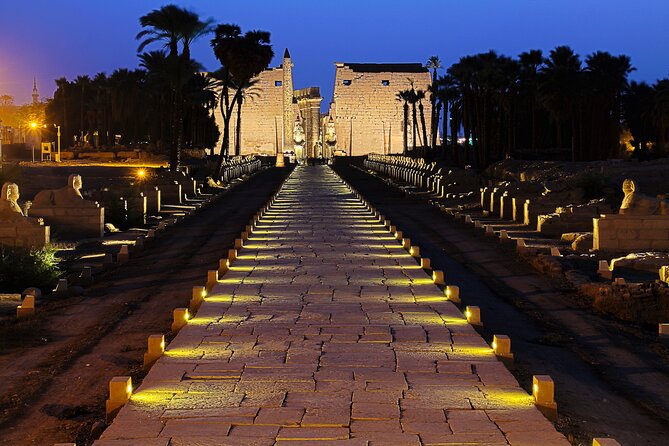Discover the wonders of ancient Egypt on this fun and interesting full-day tour from Hurghada to Luxor. After the pick-up at your hotel you will explore the Temple of Karnak, Hatshepsut, the impressive Valley of the Queens, the Colossi of Memnon and take a boat tour cross the River Nile.
* Duration: 14 to 16 hours
* Starts: Hurghada, Egypt
* Trip Category: Cultural & Theme Tours >> Cultural Tours
Discover the wonders of ancient Egypt on this fun and interesting full-day tour from Hurghada to Luxor. After the pick-up at your hotel you will explore the Temple of Karnak, Hatshepsut, the impressive Valley of the Queens, the Colossi of Memnon and take a boat tour cross the River Nile.
Itinerary
This is a typical itinerary for this product
Stop At: Valley of the Queens, Luxor Egypt
The Valley of the Queens ( W?d? al Malek?t) is a site in Egypt, where the wives of pharaohs were buried in ancient times. It was known then as Ta-Set-Neferu, meaning “the place of beauty”. It was most famous for being the burial site of many wives of Pharaohs. Pharaohs themselves were buried in The Valley of the Kings.
Visit the Temple of Karnak and admire the columned halls, the chapels, and the sacred lake of the UNESCO World Heritage Site. Enjoy lunch at a selected restaurant in Luxor before heading to the other bank of the Nile River with a Feluka.
Here you will explore the City of the Dead and the Colossi of Memnon. Admire the only remains of the Temple of Amenhotep III and visit the Valley of the Queens. Be inspired by the stunning architecture and discover the Temple of Hatshepsut, the great queen of all times who ruler of ancient Egypt. Finally, as your day winds down, you will be transferred back to land and returned to your hotel.
Duration: 2 hours
Stop At: Temple of Hatshepsut at Deir el Bahari, Kings Valley Rd Deir el-Bahari, Luxor 23512 Egypt
Hatchepsut; Egyptian “Foremost of Noble Ladies”;[5] 15071458 BC) was the fifth pharaoh of the Eighteenth Dynasty of Egypt. She was the second historically-confirmed female pharaoh, the first being Sobekneferu.[6] (Various other women may have also ruled as pharaohs regnant or at least regents before Hatshepsut, as early as Neithhotep around 1600 years prior.)
Duration: 1 hour
Stop At: Karnak Open Air Museum, You Require a separate ticket within the walls of Karnak Temple, Luxor Egypt
The Karnak Temple Complex, commonly known as Karnak (/?k??r.næk/,[1] from Arabic Khurnak meaning “fortified village”), comprises a vast mix of decayed temples, chapels, pylons, and other buildings near Luxor, in Egypt. Construction at the complex began during the reign of Senusret I in the Middle Kingdom (around 2000-1700 BC) and continued into the Ptolemaic period (305 – 30 BC), although most of the extant buildings date from the New Kingdom. The area around Karnak was the ancient Egyptian Ipet-isut (“The Most Selected of Places”) and the main place of worship of the eighteenth dynasty Theban Triad with the god Amun as its head. It is part of the monumental city of Thebes. The Karnak complex gives its name to the nearby, and partly surrounded, modern village of El-Karnak, 2.5 kilometres (1.6 miles) north of Luxor.
Duration: 2 hours
Stop At: Colossi of Memnon, Thebes, Luxor Egypt
The Colossi of Memnon (Arabic: el-Colossat or es-Salamat) are two massive stone statues of the Pharaoh Amenhotep III, who reigned in Egypt during the Dynasty XVIII. Since 1350 BCE, they have stood in the Theban Necropolis, located west of the River Nile from the modern city of Luxor.
Duration: 30 minutes






